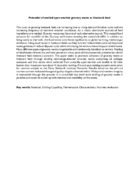| dc.description.abstract | The costs of growing livestock feed are increasing due to rising fuel and fertilizer costs and the increasing frequency of extreme weather conditions. As a result, alternative sources of feed ingredients are needed. Grocery waste may be one of such alternative source. This wasted food accounts for one-fifth of the Country solid waste entering the nation’s landfills. In addition to being costly to deal with, this food waste contributes significantly to global warming, methane gas emissions. Using food waste in livestock feeds can help farmers reduce feed costs and help food waste generators reduce disposal costs while minimizing the environmental impacts of this waste. Many different types of grocery waste are palatable and nutritionally beneficial to animals. Feeding of food waste remains is a common practice in many parts of the country but preservation of the livestock feed remains a concern. This paper seeks to promote utilization of grocery waste as livestock feed through ensiling technology.Assoted Grocery waste comprising of cabbage, tomatoes and fruit waste were collected from a nearby open market and ensiled in 20 litter bucket silos. Inspection was done 14 days after ensiling. Pre and post ensiling samples were taken for nutrient analysis at the Dairy Research institute, Naivasha. Results based on the pH and nutrient content indicated that good quality silage is obtained within 14 days and nutrient integrity is maintained through the process. It is concluded that small scale ensiling of grocery waste is possible and could be scaled up with demand and availability of the waste.
Key words: Potential, Ensiling Capability, Fermentation Characteristics, Nutrient evaluation | en_US |

